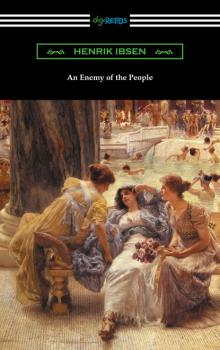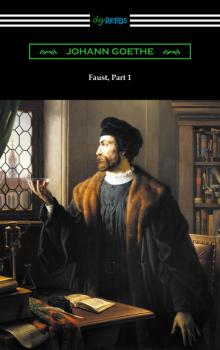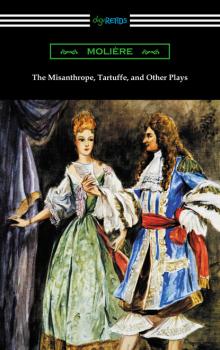Зарубежная драматургия
Различные книги в жанре Зарубежная драматургияHedda Gabler
Performed for the first time in 1891, “Hedda Gabler” is one of Henrik Ibsen’s greatest dramas. It is the story of its title character, Hedda, a self-centered and manipulative woman who has grown bored of her new marriage to the kind and reliable George. Hedda was born to a life of luxury and privilege and marries a man she does not love to avoid becoming a spinster. After returning from her honeymoon, Hedda discovers that her marriage will not be the life of wealth and excitement she was accustomed to and that George will never be the ambitious and successful man she wishes him to be. To escape her boredom, she begins to meddle in the lives of George’s academic rival, Eilert, who is Hedda’s former paramour, and Eilert’s unsuspecting wife, Thea. Hedda fears that Eilert and his professional success may stand in the way of George’s future in academia and Hedda takes it upon herself to sabotage her husband’s rival, leading to truly tragic consequences for everyone involved. Marked by one of the most dramatic female roles in all of theater, “Hedda Gabler” stands as an enduring masterpiece by Norway’s most famous playwright, Henrik Ibsen. This edition includes a biographical afterword, follows the translation of Edmund Gosse and William Archer, with an introduction by William Archer.
Six Characters in Search of an Author
First performed in 1921 with Romans calling out ‘Madhouse!’ from the audience, “Six Characters in Search of an Author” has remained the most famous and innovative of Pirandello’s plays. Often labeled a satirical tragicomedy, this play initiated the anti-illusionism movement of the early twentieth century, rejecting realism in favor of a more symbolic, dreamlike quality. When an acting company’s rehearsal is interrupted by six family members who wish their life story to be enacted, the result is a masterpiece in the exploration of the nature of human personality. Both popular and controversial, this play blurred the lines of reality and illusion in unpredictable ways, ultimately influencing later playwrights like Beckett and Sartre with its bizarre blending of theatrical qualities. Such is the eloquence and depth of Pirandello’s body of work that he was awarded the Nobel Prize in 1934, just two years before his death, an honor worthy of a playwright whose plays had a subtle yet profound impact on much of the theatre that would follow. This edition follows the translation of Edward Storer.
The Cherry Orchard
Written in 1903, “The Cherry Orchard” was Anton Chekhov’s final play, widely regarded as one of his greatest dramatic accomplishments. It is a story set during the decline of the aristocracy and the rise of an emergent middle class in Russian society at the turn of the 20th Century. Madame Ranevsky and her daughters have returned to their family estate, including its famous cherry orchard, to oversee the auction of the estate in order to pay the mortgage. Madame Ranevsky is paralyzed by the thought of losing the sentimental cherry orchard and all that the loss of the family estate represents and has no grasp of the financial and legal issues she faces. Rather than see her family’s property divided and sold off so that she can keep a small piece of it, it is instead sold to the son of a former serf. Ultimately the now destitute family leaves to the sound of the beloved orchard being chopped down, the symbolic and metaphoric end to an era. The vast social and financial upheaval at the end of the 20th century in Russia, which ultimately led to the Socialistic Revolution, is excellently portrayed in Chekhov’s “The Cherry Orchard.” In turns melancholy and comedic, this timeless dramatic masterpiece continues to move audiences to this day. This edition includes a biographical afterword and follows the translation of Julius West.
An Enemy of the People (translated by R. Farquharson Sharp with an introduction by Otto Heller)
First performed in 1882, Henrik Ibsen’s “An Enemy of the People” is the story of the animosity that can befall someone whose actions, while in the best interest of the public good, threaten the economic well being of a community. The story begins during an evening of entertaining at the household of Dr. Stockmann, the titular “enemy of the people”. When the mayor of the town, Dr. Stockmann’s brother Peter, and the editor of the town newspaper, Hovstad, come to Dr. Stockmann’s home, he is confronted over the rumors that the water of the town baths may be contaminated. The two brothers argue over the morality of concealing or falsely shaping the narrative in regards to the problem. When a letter arrives confirming the contamination, Dr. Stockmann convinces Hovstad that he must publish the report, which sets into motion a great conflict amongst the townspeople over the financial cost of dealing with the contamination. In this tensely dramatic work we find Ibsen at his best in addressing the economic consequences of doing the right thing. This edition follows the translation of R. Farquharson Sharp, includes an introduction by Otto Heller, and a biographical afterword.
The Cherry Orchard and Other Plays
Collected in this volume are five of Chekhov’s most popular dramatic works: “Ivanov”, “The Sea-Gull”, “Uncle Vanya”, “Three Sisters” and “The Cherry Orchard”. Firstly in “Ivanov” we find the taut psychological drama of Nikolai Ivanov, a man who is severely conflicted by the illness of his wife, his mounting debts, and his own internal desires. Secondly, “The Sea-Gull” is the story of the romantic and artistic conflicts between four main characters: Nina, the daughter of a wealthy landowner; Madame Irina Arkadina, a once leading actress; Konstantin Treplyov, her son and a playwright; and Trigorin, a well-known writer. Thirdly, “Uncle Vanya” is a melancholic portrait of a cast of characters examining their respective miseries and failures to accomplish in their lives that which they might have hoped to. Fourthly, “Three Sisters” is a story which concerns the lives of an aristocratic family, the Prozorovs, who struggle to search for meaning in the modern world. Lastly “The Cherry Orchard” is the tale of an aristocratic Russian woman and her family who return to their estate, a cherry orchard, to oversee its auction in order to pay the mortgage. Taken together this collection of dramas exhibits Chekhov’s literary prowess and provides a brilliant portrait for the dramatic social environment of Russia at the turn of the 20th century. This edition follows the translations of Marian Fell and Julius West and includes a biographical afterword.
The Misanthrope (Translated by Henri Van Laun with an Introduction by Eleanor F. Jourdain)
Jean-Baptiste Poquelin, known popularly by his stage name Molière, is regarded as one of the masters of French comedic drama. When Molière began acting in Paris there were two well-established theatrical companies, those of the Hôtel de Bourgogne and the Marais. Joining these theatrical companies would have been impossible for a new member of the acting profession like Molière and thus he performed with traveling troupes of actors in the French provinces. It was during this period that Molière would refine his skills as both an actor and a writer. Eventually his reputation would increase allowing him to return to Paris where he gained the patronage of Philippe I, Duke of Orléans, the brother of the King of France, Louis XIV. In this volume one of Molière’s most popular works is presented, one in which the author draws upon his bourgeoisie upbringing in 17th century France. “The Misanthrope” is a comedy of errors which satirizes the hypocrisies of French aristocratic society. The story is concerned with the relationship between Alceste, a French gentleman who laments the superficiality of society life, and Célimène, a woman who epitomizes the courtly manners that Alceste despises. This edition is translated by Henri Van Laun, includes an introduction by Eleanor F. Jourdain, and a biographical afterword.
Faust, Part 1 (Translated by Anna Swanwick with an Introduction by F. H. Hedge)
Considered by many as Johann Goethe’s magnum opus, “Faust” has a peculiar history of composition and publication. What began as a project in Goethe’s youth, at the age of twenty, in 1769, “Faust” would not fully be completed until 1831 very near the end of the author’s life. Based on the German legend of Johann Georg Faust, a magician of the German Renaissance who reportedly gained his mystical powers by selling his immortal soul to the devil, the Faustian legend has forever come to symbolize the inherent peril in dealing with unscrupulous characters and supernatural forces. Presented here in this volume is the first part of “Faust”, which begins with a prologue in heaven in which we find god challenging the devil that he cannot lead astray one of his favorite scholars, Dr. Faust. The devil, known in the play as Mephistopheles, accepts the challenge and so begins the struggle of Faust between the allure of supernatural power and the fate of his soul. Despite numerous adaptations, Goethe’s “Faust” stands out as arguably the most famous version of this legend. Only Christopher Marlowe’s “Dr. Faustus” can be claimed to rival it for that position. This edition is translated by Anna Swanwick, includes an introduction by F. H. Hedge, and a biographical afterword.
Cyrano de Bergerac (Translated by Gladys Thomas and Mary F. Guillemard with an Introduction by W. P. Trent)
Based on the real life of the seventeenth century French dramatist of the same name, “Cyrano de Bergerac” is Edmond Rostand’s classic romantic play. Cyrano, a cadet in the French Army, is a talented duelist, poet, and musician, however he has extreme self-doubt in matters of love due to the large size of his nose. Cyrano is conflicted by his inability to summon the confidence to tell the woman that he adores, Roxane, how he truly feels. He writes her a letter expressing his love with the intent of giving it to her during a rendezvous, however, when he learns that Roxane is in love with another, a handsome new cadet, Christian de Neuvillette, he withholds his admission. Christian lacks the intellect and wit to woo Roxane and enlists the help of Cyrano who, despite being against his own self-interest, agrees. First performed in 1897, “Cyrano de Bergerac”, is one of the most popular plays in the French language, which brilliantly dramatizes the idea that beauty is only skin deep and that true love is about more than just physical attractiveness. This edition follows the translation of Gladys Thomas and Mary F. Guillemard and includes an introduction by W. P. Trent.
The Importance of Being Earnest and Other Plays
“The Importance of Being Earnest and Other Plays” brings together Oscar Wilde’s most popular plays which first appeared between 1891 and 1895. Despite his relatively short theatrical career, Wilde’s plays have enjoyed a sustained popularity. A classic satire of Victorian society, “The Importance of Being Earnest” is one of the author’s most frequently performed works. The play trivializes its characters, who through a series of deceptions pretend to be people that they are not in order to escape the burdensome demands of social conventions. “Salome”, originally written in French, is a retelling of the Biblical story of Salome, who requests the head of John the Baptist, Jokanaan in the play, for dancing the dance of the seven veils. “A Woman of No Importance” concerns Mrs. Arbuthnot, a woman who has been scorned by society for having an illicit affair and conceiving a child out of wedlock. “An Ideal Husband” is the story of an up-and-coming politician with a secret past and the blackmail scheme to keep that secret quiet. “Lady Windermere’s Fan” is the tale of Lady Windermere who suspects her husband of infidelity when he takes an interest in Mrs. Erlynne. Largely a collection of high society satires “The Importance of Being Earnest and Other Plays” brilliantly exhibits Wilde’s dramatic deft. This edition includes a biographical afterword.
The Misanthrope, Tartuffe, and Other Plays (with an Introduction by Henry Carrington Lancaster)
Jean-Baptiste Poquelin, known popularly by his stage name Molière, is regarded as one of the masters of French comedic drama. When Molière began acting in Paris there were two well-established theatrical companies, those of the Hôtel de Bourgogne and the Marais. Joining these theatrical companies would have been impossible for a new member of the acting profession like Molière and thus he performed with traveling troupes of actors in the French provinces. It was during this period that Molière would refine his skills as both an actor and a writer. Eventually his reputation would increase allowing him to return to Paris where he gained the patronage of Philippe I, Duke of Orléans, the brother of the King of France, Louis XIV. This collection of Molière’s plays includes some of his most notable compositions. In “The Misanthrope”, a comedy of errors which satirizes the hypocrisies of French aristocratic society, the author draws upon his bourgeoisie upbringing in 17th century France. “Tartuffe” is the story of Orgon, the head of his family, who has fallen under the influence of Tartuffe, an imposter who pretends to be pious and to speak with divine authority. These plays along with “The School for Wives”, “The School for Wives Criticized”, and “The Impromptu at Versailles” exhibit the dramatist at his comedic best. This edition includes an introduction by Henry Carrington Lancaster and a biographical afterword.









